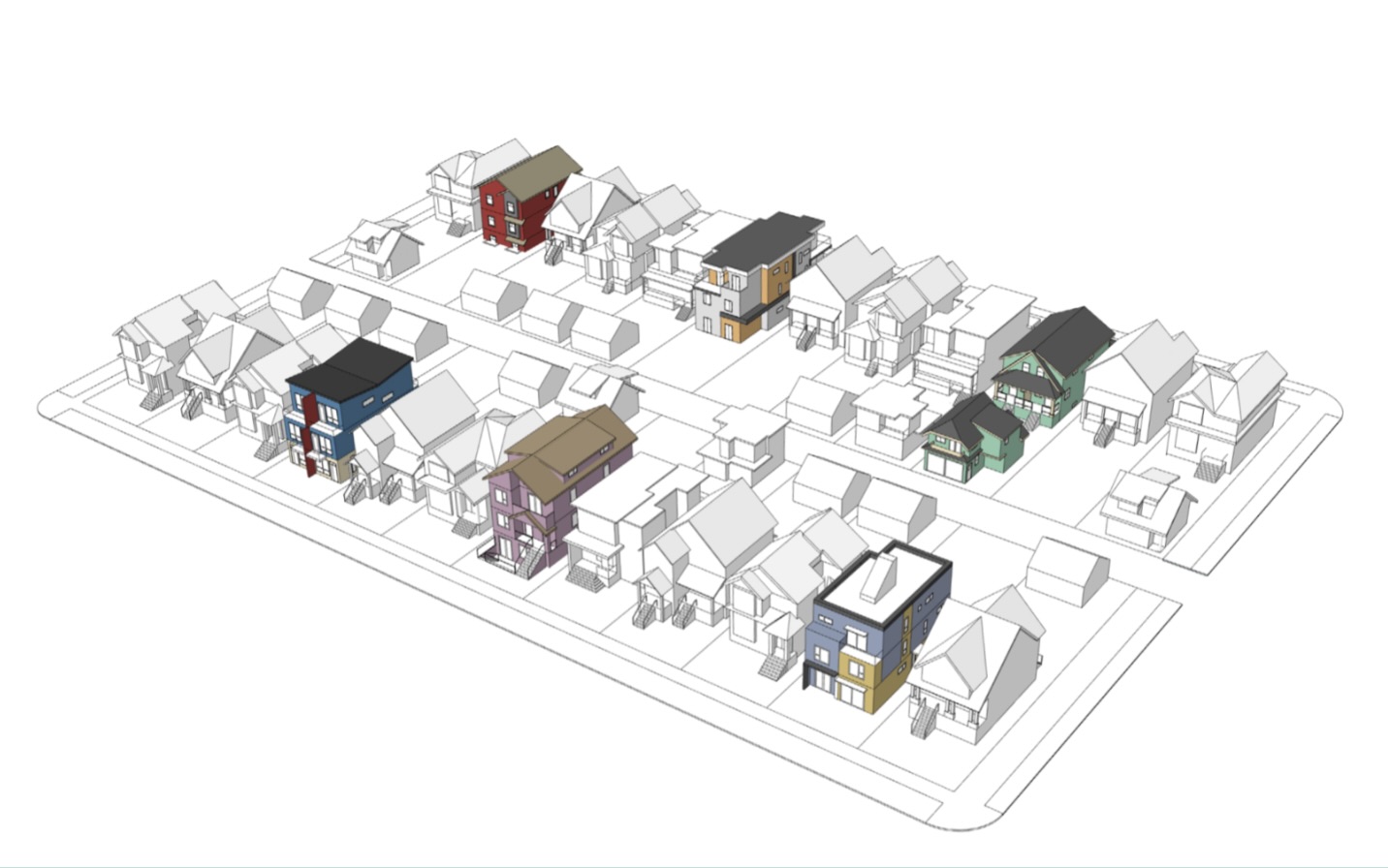
Feb 6, 2023: City Launches Missing Middle Survey
Last month, Vancouver City Council threw its support behind a staff proposal to allow multiplexes, townhouses, and low-rise apartment buildings in all low-density residential (RS) areas of the city. Now they want to hear from you.
Whether you currently live in an RS zone or would one day like to rent or own your own home on a shared lot, this is one of your few chances (possibly your only opportunity) to have a say.
The “Adding Missing Middle Housing and Simplifying Regulations in Low-Density Neighbourhoods” public opinion poll is now open on the Shape Your City page of the City’s website (scroll down the page and click on “Survey”) until March 5. The City will also be hosting a slate of in-person information sessions across town, from Feb. 7 to 25, as well as one electronic meeting on Feb. 27, 6:00 pm-7:00 pm. (Registration closes on Feb. 19).
Upper Kitsilano residents: mark Saturday, Feb. 11, 2:30-5:30 pm at St. James Square Community Centre, Room 120, on your calendars.
(Note: UKRA recommends that caution be exercised when answering the survey. Keep in mind that most City polls are manufactured for consent. In the past, we have observed that many questions in similar City surveys lack pertinent information and sufficient background for residents to make an informed decision. If you require more information on the Missing Middle, you can email UKRA through the “Contact” portal. We are happy to provide background information).
What’s In the Missing Middle Policy?
Middle-Missing Housing includes structures that fall between single-detached homes and towers. (Please note in picture above, courtesy of the City of Vancouver, duplexes are already permitted in RS zones).
The City hopes to replace expensive detached homes with three-to-six-unit multiplexes, possibly townhouses, and low-rise apartment buildings (depending on lot size), to make room for a growing population. Since there is very little heritage or character housing protection in Vancouver, many older homes in RS zones will be at risk of demolition if the proposal passes.
Introducing these new housing types to residential neighbourhoods must be done quickly to ease the housing crisis, and therefore onerous building rules must be simplified, say City planners. Standardizing the rules would give developers certainty by following more straightforward rules than currently apply. The City says this will allow a wider range of housing designs. But will developers put the time and thought into the needs of each neighbourhood, or will we continue to see monotonous rows of bland boxes? There is nothing here to require builders to consult with residents before they permanently alter RS neighbourhoods.
The City is also considering designating some of the new housing to below-market rates that would allow family ownership aimed at households making approximately $140,000 per year.
City staff acknowledge prices of Missing Middle housing won’t be cheap. An average unit on Vancouver’s Eastside will cost over $1.1 million to own. This calls for a yearly income of approximately $235,000.
As Andy Yan, director of Simon Fraser University’s City Program tells Real Estate reporter Kerry Gold in a Globe and Mail Feb.3 story, Single family houses, multifamily homes, “They [the City] are operating on the premise that more housing is more affordable housing, and the reality is, it isn’t for low and middle renters,” Prof. Yan said.
One important thing the City hasn’t considered, says Yan, is the “hidden” Missing Middle in RS zones. Existing secondary rental units represent about half the city’s rental stock. Yan’s 2021 analysis, writes Gold, shows more than 40 per cent of West Point Grey, Arbutus Ridge, Victoria-Fairview, South Cambie, Kerrisdale, Oakridge, Hastings-Sunrise, Riley Park, Killarney, Renfrew-Collingwood and Kensington Cedar Cottage households are renters; more than 50 per cent of households in Kitsilano, Marpole and Fairview are renters; and 60 per cent of Mt. Pleasant and 64 per cent of Grandview-Woodland rents. Shaughnessy and Dunbar have 28 per cent and 26 per cent of renter households, respectively.
“There is already a Missing Middle that exists in the city of Vancouver that needs to be acknowledged and engaged,” says Prof. Yan. “As they [City] go after this new Missing Middle for home ownership and launch a new wave of building, you will have a displacement effect.”
The Missing Middle proposal is not a new idea, but rather one that got stalled under the leadership of former mayor Kennedy Stewart. Stewart’s “Making Home” plan — which introduced the idea of building up to six strata units on one lot — eventually passed, and the current ABC majority is running with it. The Missing Middle is the beginning of what the Vancouver Plan envisions for the city over the next 30 years: heavy densification.
Concerns
While we support the idea of adding low-rise construction in keeping with the character and needs of people living in each neighbourhood, UKRA has several concerns about this new proposal, namely:
- Will the new housing be truly affordable? As we reported in our last newsletter, the City estimates a typical new Missing Middle unit on Vancouver’s East side will cost $1.1 million;
- The City does not have an accurate list of secondary suites in RS neighbourhoods, but we estimate a huge number of tenants paying some of the most affordable rents in the city could face demoviction if the plan is approved;
- Complete absence of neighbourhood planning. Those who live in RS zones—tenants and landlords alike—were not included in the planning of the Missing Middle proposal; however, developers were;
- Along with pre-1940 character houses, the proposal will see the loss of many trees of all ages and species, and green spaces, which could compromise the habitat of various flora and fauna, and the loss of shade/cooling;
- No on-site parking provided: more vehicles will compete for spaces on city streets;
- We don’t know what the uptake will be, but will Vancouver’s aging infrastructure support the additional development? According to Donny Wong of Engineering, increasing density beyond the current Missing Middle plan would strain Vancouver’s aging sewer system;
- The proposal doesn’t account for the resulting larger, denser population. Where are new schools, senior centres, and other neighbourhood facilities going? What will they cost?
- Loss of privacy, increased shadowing;
- Who benefits from the plan? Will the proposal help locals find more places to live, or will it encourage local and global investors/REITS to move in? How will the City prevent this from happening? How will land inflation affect housing process?
For an interesting read on how the supply and demand of housing argument is not working in Vancouver, see this story in The Tyee by outspoken UBC Urban Design professor, Patrick Condon.



No Comments